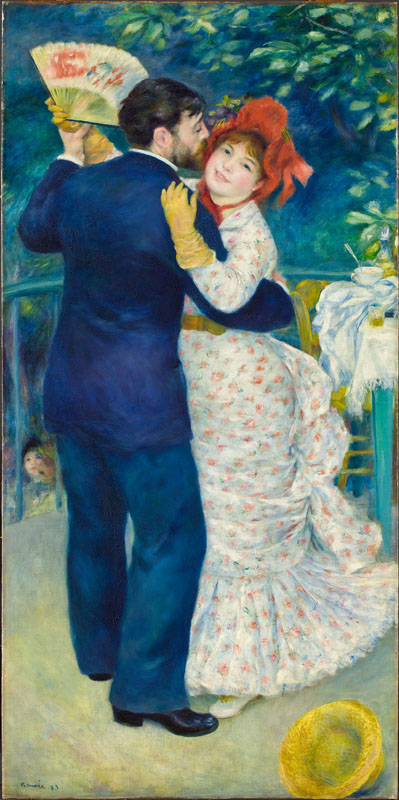Listen to director and curator Colin Bailey describe one of Renoir’s iconic images of contemporary life.

This full-length canvas of a couple on the terrace of a country inn was one of three large paintings of dancers Renoir made in his Paris studio during the winter of 1882–83. Here, his models were the dashing journalist Paul Lhote and Aline Charigot, Renoir’s twenty-three-year-old companion.
Dancers (Bougival) or Dance in the Country, 1883
Oil on canvas
Musée d’Orsay, Paris; RF 31717
Musée d'Orsay, dist. GrandPalaisRmn. Photography by Patrice Schmidt.
A young woman in light summer dress and bright red-orange bonnet smiles out at the viewer as she spins across the terrace of a café in the arms of her partner, who gazes at her intently. The scene is set in an unidentified suburb of Paris, at the kind of entertainment venue that was crowded on the weekends with both local townspeople and visitors from Paris seeking a night out away from the city. The painting is one of a pair of ambitious, large-scale images of contemporary society that Renoir exhibited at the Durand-Ruel Gallery in Paris, in March 1883, in a mid-career survey of seventy works. The other painting, Dance in the City, shows a couple in Paris in formal dress and a more subdued and elegant setting. Renoir’s friend, the writer Paul Lhote, posed for the man in both works, and Aline Charigot, the artist’s companion, posed for the woman here. Dance in the Country represents Renoir’s effort in the early 1880s to combine the vivid light and lively outdoor setting of his Impressionist paintings with more clearly defined and structured forms. In keeping with that goal, he also made numerous preparatory drawings for this work (although not for the companion painting), in which he established the dancers’ poses and tested different options for the colors and patterns of their clothing. Several months later, he also made two drawings that copied the finished painting, one in vigorous strokes of ink, the other in more carefully detailed ink, crayon, and graphite, to be reproduced in the journal La Vie moderne.
